#william cronon
Text

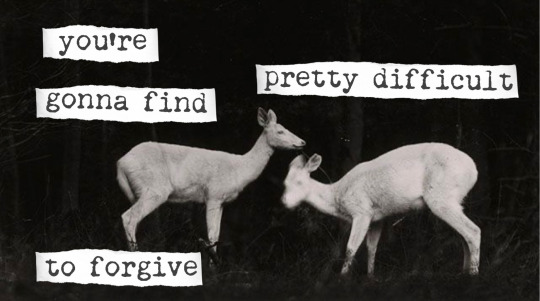





THE WOLVES BIT THEIR WAY OUT; ON NATURE
@gnawgag // william cronon // william shakespeare // @gnawgag // jack london // reg saner // sunlightafterdark (instagram)
#william cronon#shakespeare#jack london#reg saner#web weaving#on nature#on forests#webweaving#quotes#poetry#writing
1K notes
·
View notes
Quote
In his Changes in the Land (1983), William Cronon documented how Puritan ideas of Eden—an imaginary explicitly invoked by Monbiot’s title—distorted perceptions of the place the colonizers called New England. They perceived the Abenaki tribes as primitives in a paradise where deer abounded, forests provided good things to eat and soils were good for growing maize. Paradise fell apart when the settlers divided and fenced the land, not understanding that the indigenous peoples practised what would now be called agroforestry, attracting deer to specific places.
Harriet Friedmann, Farming Futures
93 notes
·
View notes
Text

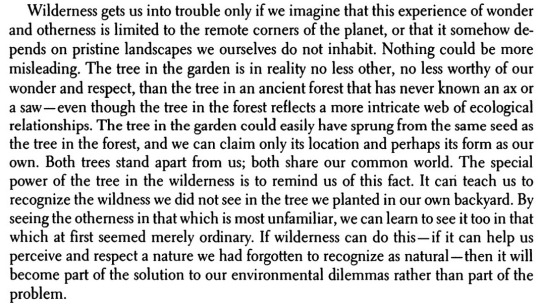
--William Cronon, "The Trouble With Wilderness"
12 notes
·
View notes
Text
All human groups consciously change their environment to some extent—one might even argue that this, in combination with language, is the crucial trait distinguishing people from other animals.
Changes in the Land by William Cronon
3 notes
·
View notes
Text
Reframing Narratives With Ecocriticism, With Dr Jenny Kerber
In this episode, Ariel discusses the topic of ecocriticism with Dr Jenny Kerber, Associate Professor of English at Wilfrid Laurier University.
What is ecocriticism? Why is it important, especially for environmental activists and solarpunks, as a narrative reframing device? Solarpunks work very closely with speculation and imagination and as architects of the narratives by which we live our…

View On WordPress
#academia#Anthropocene#critical engagement#ecocriticism#environmentalism#hope#literary studies#narrative#narrative device#nature#solarpunk#speculation#wilderness#William Cronon
4 notes
·
View notes
Photo

Changes In The Land. Greenhouse Affect #33. Published in the Boston Compass.
#climate change#global warming#environmentalism#boston#massachussetts#history#18th century#environmental history#changes in the land#william cronon
3 notes
·
View notes
Text
The Trouble with Wilderness; or Getting Back to the Wrong Nature from William Cronon
#The Trouble with Wilderness; or Getting Back to the Wrong Nature#William Cronon#Natural Connections#Bookshelf#Tumblr Staff Has Ruined Links Now And I Hate Them For It#The Trees Speak
0 notes
Text
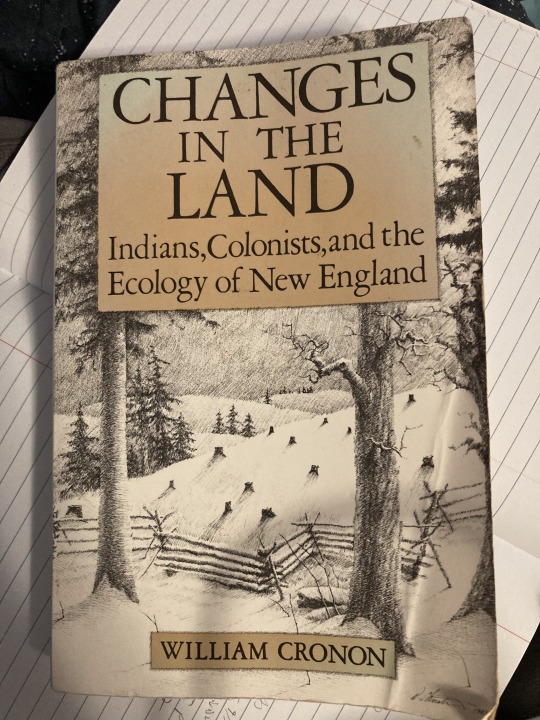
Finished the i-bought-this-book-bc-it-might-mention-blorbo-from-the-1600s and it DOES mention blorbo from the 1600s but also it's just incredibly fascinating to learn about the ecological changes in that period (1600-1800, roughly) and how they're intertwined with the economic changes. Did not expect to be genuinely interested by 20 pages of how different tree species and plants affect the soil, but here we are. It's written in a way that's very easy to understand and that does a great job of pulling you in and giving you the reasons *why* oaks taking over bc the soil was dry is something important. It's not strictly ecology, but more of an ecological perspective on economics and societal change, and it's about emphasizing the need for ecology and the environment to be viewed/studied as a part of history, rather than as merely a backdrop to it. He also talked about the 1600s in the colonies having a very early-capitalist economy (though it wasn't called that yet), and one of the major differences he points out between the Native Americans' relationship with the environment and the colonists' relationship with the environment is that while the Native Americans viewed things as resources, i.e. in terms of its value strictly for it's usefulness, the colonists viewed natural resources as commodities that had value because of their sale price.
He also opened the book with a quote from Marx, which I think is very cool of him:
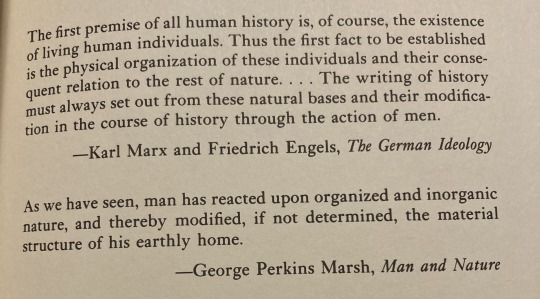
#this is just proof i need to read more blorbo books <3#i want to read more of his writings but i think reading 200 pages of 1600s church infighting might actually kill me#i should see what else william cronon's written#changes in the land
3 notes
·
View notes
Text
okay. so.
i'm reading this book The Origins of the Modern World by Robert Marks
and even from the beginning i was getting this weird feeling from it. I'm always really wary of books that are broad overviews of history that claim to explore big theory-of-everything explanations for very broad phenomena, because history is unbelievably complex and there is so much disagreement between historians about everything.
But anyway I come to this section (in the first chapter)
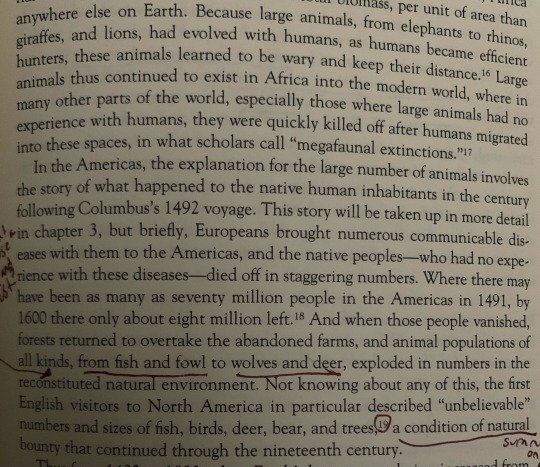
This writer's opinion is that the Americas seemed so abundant when English settlers first arrived because the Native Americans had been mostly killed, and as a result, the wildlife increased greatly in numbers and forests overtook the farms, creating what appeared to be a natural paradise.
I'm immediately suspicious of this paragraph because arguing that the mass death of Native Americans was good for nature seems really contradictory to the research I've explored, on top of being just...disgusting.
But it doesn't sound right in regards to how ecosystems work either. If populations of animals had recently exploded after millennia of being limited by a major predator, it would cause the plants to be overwhelmed by the herbivore populations. The land would be stripped barren and eroded, and soon the animals would be weak and starving.
So I thought to myself, huh, a citation. I will look at the citation and see what it says.
It's a book called Changes in the Land by William Cronon, who seems to be one of the most important and respected guys in his field. I thought, I have to find this book. So I did, I found the book, and spent like an hour reading through it.
And what I discovered, is that Cronon's book directly contradicts what Marks says in the paragraph that cites Cronon?!

So basically this entire book, Changes in the Land, is a detailed exploration of how the arrival of English settlers, the decline of Native American populations, and the slow transition to European farming and land use practices caused increasing degradation to the ecosystem, beginning very early on in colonization.
Changes in the Land quotes a great array of documents from the colonial period where settlers observed the soil becoming depleted, animals disappearing, and the climate itself becoming more hostile even in the 1600's. It's actually a really fascinating book.
Cronon tells us that Native Americans created lush and abundant conditions for wild animals by causing a "mosaic" of habitats, with different areas representing various stages of ecological succession. With this great diversity in habitats, and lots of transitional "edges" between them, the prosperity of the animal life was maximized. This was intentional, and really a type of farming.
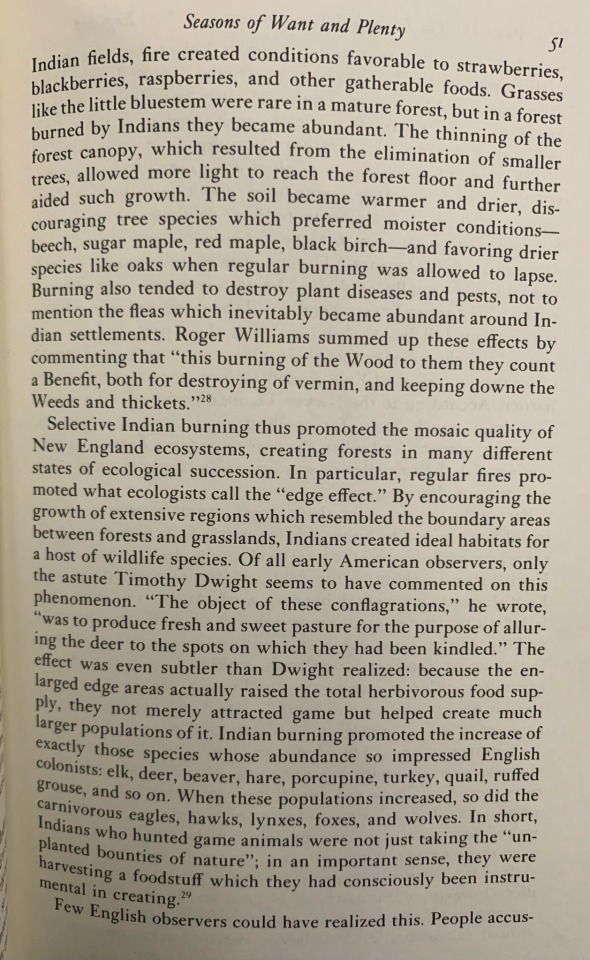
The book essentially explains how European settlers couldn't recognize Native American life ways as "agriculture," they thought the land was just supernaturally abundant all by itself because of its inherent nature, and yet almost immediately after settlers came, the abundance of the land degraded and vanished. The settlers cut down vast amounts of trees, which caused erosion, which destroyed the river and stream ecosystems and starved the soil of nutrients. Destruction of forest caused less rain, and more extreme temperatures. It became a vicious cycle where the settlers had to abuse the land more and more just to survive.
The spiral pulled in Native American communities too, forcing them to turn to more exploitative means of survival like the fur trade, (which depleted the beaver population, which caused the decline of beaver ponds, which harmed the whole forest). It describes how the changing ecosystems left Native Americans with no choice but to turn to European practices for survival, which in turn depleted the land even further.
Even I was surprised to learn just how early on environmental disaster set in, and the incredible extent of it. English farming practices literally reshaped the map of New Haven between the 17th and 18th centuries:
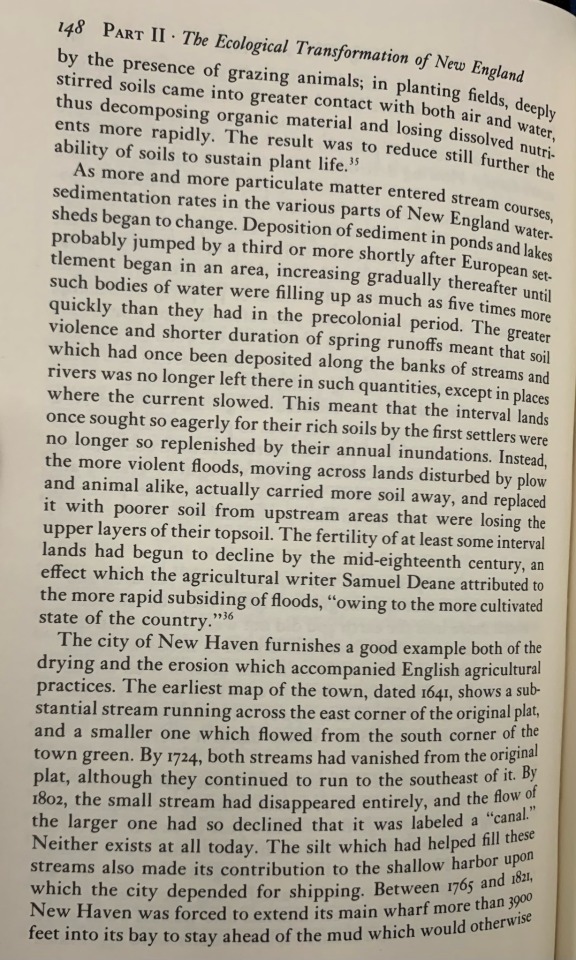
To return to Marks, though...Marks' statement in the excerpt, where he says the "abundance" of animals continued throughout the 19th century, is blatantly false according to the source HE CITES.
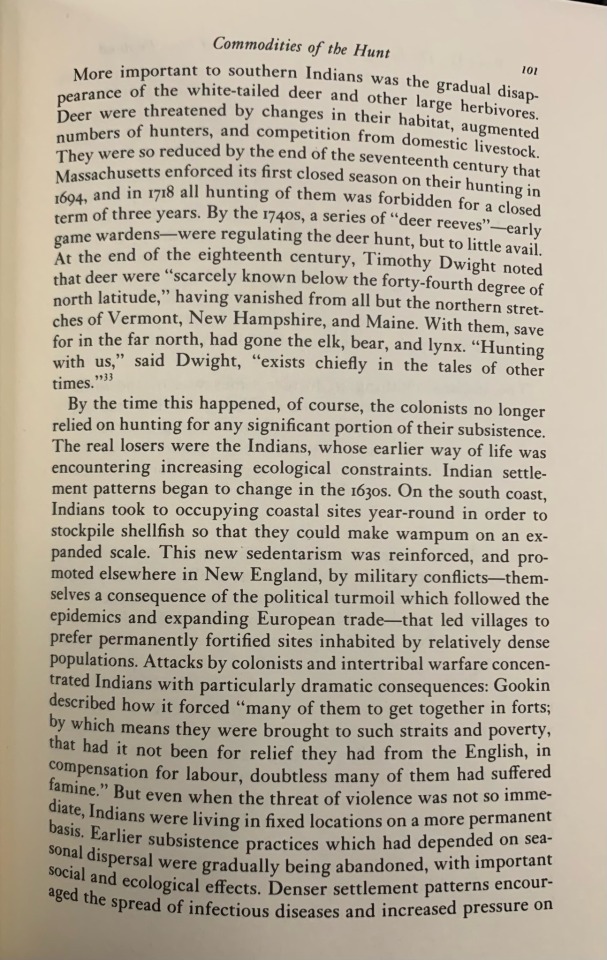
Deer were becoming scarce in New England by the 1690's. It was so bad by 1718 that deer hunting was forbidden for 3 years at that time, and by 1800, deer were almost extirpated from New England. The book explains on another page that wild turkeys became so rare that a farmer's manual from the time said their domesticated turkeys were from Turkey—settlers had no opportunity to see a wild turkey and no idea they existed.
Marks is supporting his statement using a source entirely dedicated to contradicting the exact thing he's saying! It's unbelievable.
How does this happen? Did Marks just have his own opinion and insert a famous book that seemed to be on the subject as support, without reading it?
I'm thinking now of all the times I've read a book and seen a citation on a statement and unconsciously thought "oh, well it seems there is evidence, so it must be reliable" when actually, something like this was happening. The array of ways misinformation can be propagated and never be found out is terrifying.
2K notes
·
View notes
Photo










BENEATH THE TREES, WHERE NOBODY SEES
teddy bears' picnic (1932) / men (2022) / the trouble with wilderness by william cronon / the blair witch project (1999) / six theses on plant horror by dawn keetley / evil dead (2013) / american gods (2017) / in the earth (2021) / gretel & hansel (2020)
#horror where the woods/plants/trees are a character in and of themselves are <333333#web weaving#parallels#horroredit#notes from the chills#genre notes#forest#the woods#plants#horror#men 2022#the blair witch project#evil dead 2013#in the earth 2021#gretel & hansel#plant horror
348 notes
·
View notes
Note
What texts would you recommend to develop the sort of general knowledge needed to write something like your economic development plans? I am currently trying to write a setting which has a few major reformist leaders with big plans, and it would really help to know a bit more about how to come up with a workable economic development plan for a fantasy region - I really admired your work on the subject, and thought you were the person to ask.
This is a great question!
Something I've discussed before wrt economic development, is the need to avoid presentism as much as possible. So I've always taken as a central limiter of my economic development proposals that they have to fit within the boundaries of what was known/technologically feasible during the Late Middle Ages through to the Early Modern period.
In this fashion, I try to avoid the Connecticut Yankeee in King Arthur's Court scenario where all of the sudden steam engines appear hundreds of years early out of nowhere - because we shouldn't be assuming that economic development is some teleological process that has to go through the same stages as Western European economic development did in our timeline. The result is that I got really into reading about the Commercial Revolution and the technologies that drove economic development during that period - hence why I became obsessed about canal-building, because canals were a key technology that the Early Modern nation-state used to create and reshape markets.
So here is a meta-list of books I'd recommend on economic development in the Middle Ages through the Early Modern period:
books about medieval and Renaissance governments.
William Cronon’s Nature’s Metropolis, Lawrence Goodwyn's The Populist Moment, and Will and Wong's Nourish the People on the making and remaking and regulating of agricultural markets.
books about Medieval and Renaissance urban development.
books about medieval guilds.
Robert S. Lopez' Commercial Revolution of the Middle Ages.
Joseph Gies' Merchants and Moneymen: the Commercial Revolution.
Pamela Smith, Paul Findlen ed. Commerce, Science, and Art in Early Modern Europe.
Ralph Davis' A Commercial Revolution.
Anthony Burton's The Canal Pioneers and The Canal Builders.
John Blair ed. Waterways and Canal-Building in Medieval England.
A.E.J Morris, History of Urban Form Before the Industrial Revolution.
96 notes
·
View notes
Text
Far from escaping significant human modification, areas mapped as wilderness across tropical biomes have been profoundly shaped by humans in deep time, and continue to be occupied and used by diverse Indigenous and local populations today. For example, the Amazon is thought to be a center for the domestication of over 80 crop species, including many that humans rely on today, such as cassava (Manihot esculenta), wild rice (Oryza sp.), peanuts (Arachis hypogaea), and chili (Capsicum baccatum). The domestication and cultivation of these key crop species resulted in substantial human impact over the composition and structure of soils and forests in these landscapes that continue to support significant agroecological diversity today. Despite clear human intervention in the Amazon forest system for millennia, Indigenous and local peoples’ use of these forests have promoted biodiversity and maintained forest structure. On the other side of the globe, the application of swidden agriculture—a way of farming involving rotational clearing, burning, and fallow that has been used for millennia and today supports between 14 and 34 million highlanders in tropical South and Southeast Asia —is thought to have played an important role in shaping the structure and resilience of forests, as well as maintaining diverse ecosystem services.
Indigenous knowledge and the shackles of wilderness
#indigenous#history#wilderness#agriculture#farming#There is nothing natural about the concept of wilderness. It is entirely a creation of the culture that holds it dear. - William Cronon
259 notes
·
View notes
Text

--William Cronon, "The Trouble With Wilderness"
#id in alt#environmentalism#william cronon#op#i'm on my laptop but imagine my commentary on this quote as just fire emojis forever
0 notes
Text
Our project must be to locate a nature which is within rather than without history, for only by so doing can we find human communities which are inside rather than outside nature.
Changes in the Land by William Cronon
3 notes
·
View notes
Text



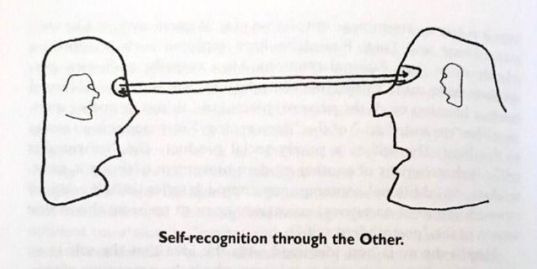



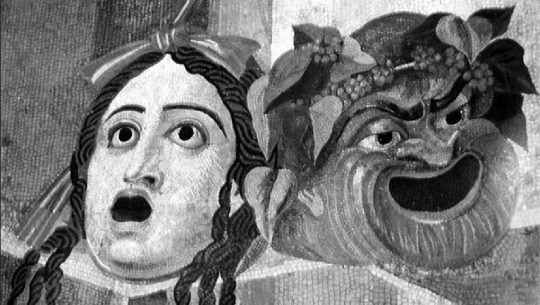


* and isn’t that godhood ? a form so divine it burns to look at @ptolomeas
" i'll be your mirror ", the velvet underground and nico ( 1966 ) / double exposure image , origin unknown / " the trouble with wilderness " , william cronon ( 1995 ) / self recognition through the other , origin unknown / " on the passion caused by the sublime " , edmund burke ( 1757 ) / you are not me and i am not you, but you and i are the same thing , unknown orgin / " the trouble with wilderness " , william cronon ( 1995 ) / mosaic showing theatrical masks of tragedy and comedy; roman artwork , hadrian's villa mosaic ( 2nd century ce ) / the secret history , donna tartt ( 1992 ) / writing excerpt , sera @ptolomeas ( 2024 ) .
#do not percieve#ft. * bunny .#i am so insane for posting this before i even post one for beckett but !#mist.weaving
9 notes
·
View notes
Text
jstor wrapped
[i nabbed this from someone and i have no idea who. bad memory wins again]
Büscher, Bram, Robert Fletcher, Dan Brockington, Chris Sandbrook, William M. Adams, Lisa Campbell, Catherine Corson et al. "Half-Earth or Whole Earth? Radical ideas for conservation, and their implications." Oryx 51, no. 3 (2017): 407-410, https://www.cambridge.org/core/journals/oryx/article/halfearth-or-whole-earth-radical-ideas-for-conservation-and-their-implications/C62CCE8DA34480A048468EE39DF2BD05. (weirdly, not on jstor.)
Cronon, William. “The Trouble with Wilderness: Or, Getting Back to the Wrong Nature.” Environmental History 1, no. 1 (1996): 7–28. https://doi.org/10.2307/3985059.
Dressler, Wolfram. “Capitalizing Conservation on Palawan Island, the Philippines.” In Nature Inc.: Environmental Conservation in the Neoliberal Age, edited by Wolfram Dressler, Bram Büscher, and Robert Fletcher, 25–43. University of Arizona Press, 2014, https://www.jstor.org/stable/j.ctt183pdh2.4. (this ones a book chapter whoa!)
Harlan, Jack R., and J. M. J. deWet. “Some Thoughts about Weeds.” Economic Botany 19, no. 1 (1965): 16–24. http://www.jstor.org/stable/4252561.
Honorable mentions:
DENEVAN, WILLIAM M. “THE "PRISTINE MYTH " REVISITED.” Geographical Review 101, no. 4 (2011): 576–91. http://www.jstor.org/stable/23208640.
Haddock, Joanna K., Caragh G. Threlfall, Bradley Law, and Dieter F. Hochuli. "Light pollution at the urban forest edge negatively impacts insectivorous bats." Biological conservation 236 (2019): 17-28.
2 notes
·
View notes